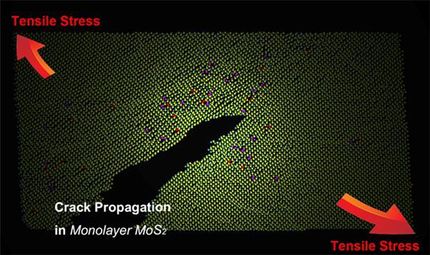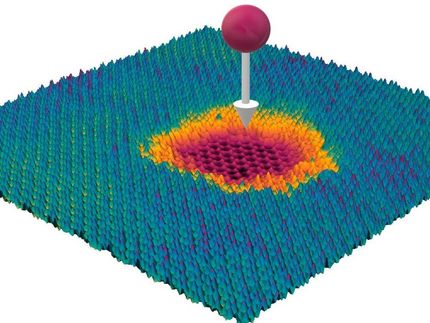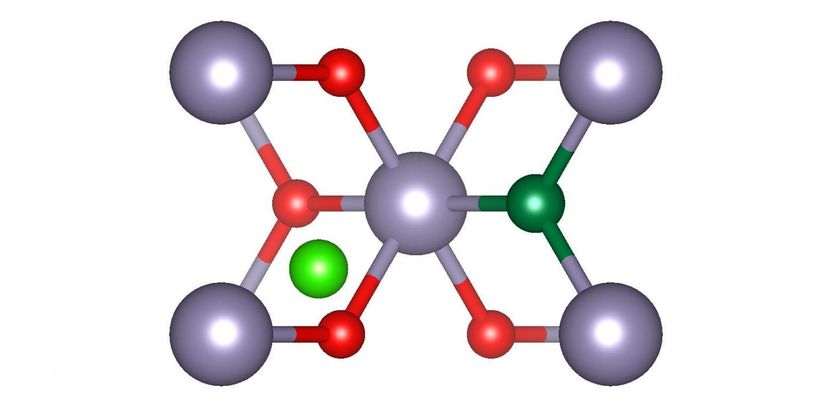The fine-tuning of two-dimensional materials
A new understanding of why synthetic 2-D materials often perform orders of magnitude worse than predicted was reached by teams of researchers led by Penn State. They searched for ways to improve these materials' performance in future electronics, photonics, and memory storage applications.

In situ rhenium doping of monolayer MoS2.
Donna Deng/Penn State
Two-dimensional materials are films only an atom or two thick. Researchers make 2-D materials by the exfoliation method -- peeling a slice of material off a larger bulk material -- or by condensing a gas precursor onto a substrate. The former method provides higher quality materials, but is not useful for making devices. The second method is well established in industrial applications, but yields low performance 2-D films.
The researchers demonstrated, for the first time, why the quality of 2-D materials grown by the chemical vapor deposition method have poor performance compared to their theoretical predictions. They report their results in a recent issue of Scientific Reports.
"We grew molybdenum disulfide, a very promising 2-D material, on a sapphire substrate," said Kehao Zhang, a doctoral candidate of Joshua Robinson, associate professor of materials science and engineering, Penn State. "Sapphire itself is aluminum oxide. When the aluminum is the top layer of the substrate, it likes to give up its electrons to the film. This heavy negative doping -- electrons have negative charge -- limits both the intensity and carrier lifetime for photoluminescence, two important properties for all optoelectronic applications, such as photovoltaics and photosensors."
Once they determined that the aluminum was giving up electrons to the film, they used a sapphire substrate that was cut in such a way as to expose the oxygen rather than the aluminum on the surface. This enhanced the photoluminescence intensity and the carrier lifetime by 100 times.
In related work, a second team of researchers led by the same Penn State group used doping engineering that substitutes foreign atoms into the crystal lattice of the film in order to change or improve the properties of the material. They reported their work this week in Advanced Functional Materials.
"People have tried substitution doping before, but because the interaction of the sapphire substrate screened the effects of the doping, they couldn't deconvolute the impact of the doping," said Zhang, who was also the lead author on the second paper.
Using the oxygen-terminated substrate surface from the first paper, the team removed the screening effect from the substrate and doped the molybdenum disulfide 2-D film with rhenium atoms.
"We deconvoluted the rhenium doping effects on the material," said Zhang. "With this substrate we can go as high as 1 atomic percent, the highest doping concentration ever reported. An unexpected benefit is that doping the rhenium into the lattice passivates 25 percent of the sulfur vacancies, and sulfur vacancies are a long-standing problem with 2-D materials."
The doping solves two problems: It makes the material more conductive for applications like transistors and sensors, and at the same time improves the quality of the materials by passivating the defects called sulfur vacancies. The team predicts that higher rhenium doping could completely eliminate the effects of sulfur vacancies.
"The goal of my entire work is to push this material to technologically relevant levels, which means making it industrially applicable," Zhang said.
Original publication
Kehao Zhang et al.; "Deconvoluting the Photonic and Electronic Response of 2D Materials: The Case of MoS2"; Scientific Reports; Volume 7, Article number: 16938 (2017)
K. Zhang et al.; "Tuning the Electronic and Photonic Properties of Monolayer MoS2 via In Situ Resubstitutional Doping"; Advanced Functional Materials
Most read news
Original publication
Kehao Zhang et al.; "Deconvoluting the Photonic and Electronic Response of 2D Materials: The Case of MoS2"; Scientific Reports; Volume 7, Article number: 16938 (2017)
K. Zhang et al.; "Tuning the Electronic and Photonic Properties of Monolayer MoS2 via In Situ Resubstitutional Doping"; Advanced Functional Materials
Topics
Organizations
Other news from the department science

Get the chemical industry in your inbox
By submitting this form you agree that LUMITOS AG will send you the newsletter(s) selected above by email. Your data will not be passed on to third parties. Your data will be stored and processed in accordance with our data protection regulations. LUMITOS may contact you by email for the purpose of advertising or market and opinion surveys. You can revoke your consent at any time without giving reasons to LUMITOS AG, Ernst-Augustin-Str. 2, 12489 Berlin, Germany or by e-mail at revoke@lumitos.com with effect for the future. In addition, each email contains a link to unsubscribe from the corresponding newsletter.






























































